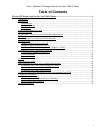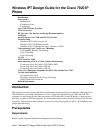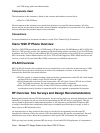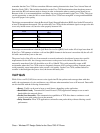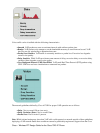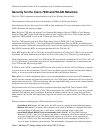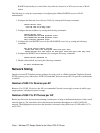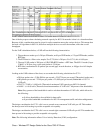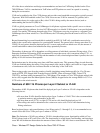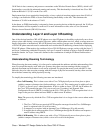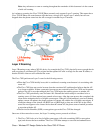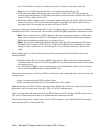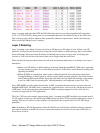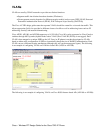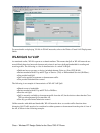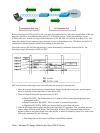All of the above calculations and design recommendations are based on VAD being disabled on the Cisco
7920 IP Phones. VAD is a mechanism in VoIP where no RTP packets are sent if no speech is occurring
during the conversation.
VAD can be enabled on the Cisco 7920 phones and provides some bandwidth conservation, typically around
30 percent. With VAD enabled on the Cisco 7920, it does not use VAD for transmit (Tx) packets, but it
understands what to do on the receive (Rx)−side if VAD is being used by the remote device (such as
understanding the Service ID (SID) bit).
VAD is a global parameter on Cisco CallManager for all phones registered with a specific server or cluster.
And the general design guidance for wired AVVID networks is to disable VAD because it can provide better
overall voice quality. This means that unless the Cisco 7920 phones are going to register to a separate Cisco
CallManager server than wired Cisco 79xx IP Phones, the VAD setting must be the same for all Cisco 79xx
phones.
Beyond determining how much bandwidth is needed for an 802.11b VoIP call, consideration must also be
made for the overall radio contention for a particular RF channel. The general rule is that no more than 15 to
25 802.11b end−points should be deployed per AP. As more end−points are added to an AP, the amount of
overall bandwidth is reduced and transmission delays potentially increase.
The number of phones per AP is dependent on calling patterns of individual customers (Erlang ratios). Cisco
Enterprise Solutions Engineering (ESE) recommends no more than seven calls (concurrent) using G.711, or
eight calls (concurrent) using G.729. Beyond that number of calls, when background data is present, the voice
quality of all calls becomes unacceptable.
Packetization rates for this testing were done with 20ms sample rates. This generates 50pps in each direction.
VAD was disabled during the testing. Using large sample sizes (such as 40ms) could result in a larger number
of simultaneous calls, but it also increases the end−to−end delay of the VoIP calls.
These testing results come from the creation of traffic simulating normal desktop traffic for 15 to 20 users
(such as HTTP, FTP, Simple Mail Transfer Protocol (SMTP), Point of Presence (POP), Telnet 3270
(TN3270)), and then adding incremental Cisco 7920 phones. The number of Cisco 7920s phones added (with
active calls) stopped when the Mean Opinion Scores (MOSs) dropped below the average MOS for G.711 or
G.729 calls on the wired network.
Numbers of 802.11b Phones per Layer 2 Subnet or VLAN
The number of 802.11b phones that should be deployed per Layer 2 subnet or VLAN is dependent on the
following factors:
No more than 30 APs should be deployed per Layer 2 subnet or VLAN. This is the recommendation
to optimize memory and performance on the APs.
•
No more than seven (G.711) or eight (G.729) active calls should be deployed per AP.•
The calling ratio used to determine active versus non−active calls. This is often determined using
Erlang calculators.
•
Based on these factors, and normal business−class Erlang ratios (3:1 through 5:1), it is recommended not to
exceed 450 to 600 Cisco 7920s per Layer 2 subnet or VLAN.
Note: The limitation of 30 APs per subnet or VLAN is introduced due to new functionality added to Cisco
WLAN clients (such as PCs) and Cisco APs. The functionality is called Secure Fast Roaming, and introduces
a new WLAN architecture that reduces the amount of time it takes a WLAN client to roam between APs. The
Cisco − Wireless IPT Design Guide for the Cisco 7920 IP Phone



